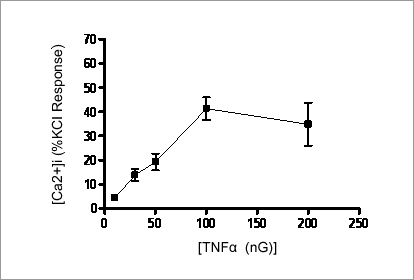Effects of TNFα on capsaicin-evoked calcium responses in adult rat dorsal root ganglion neurones
Tumour necrosis factor-α (TNFα) is a pro-inflammatory cytokine involved in the development and maintenance of inflammatory and neuropathic pain conditions. The transient receptor potential V1 ligand gated channel (TRPV1), which is activated by noxious heat and capsaicin, is involved in mediating inflammatory hyperalgesia (Davis et al., 2000) and may be modulated by inflammatory mediators such as TNFα . Here we have investigated the effects of TNFα on capsaicin-evoked changes in intracellular calcium [Ca2+]i in adult rat dorsal root ganglion (DRG) neurones, an in vitro model of sensory nerves.
Fig.1 TNFα-evoked Increases in [ Ca2+] i in DRG neurones.
Application of TNFα increased levels of [ Ca2+]i in DRG neurones ( pEC50 = -7.3; Emax=39.3% of the KCl response) (Fig. 1). Following pretreatment of DRG neurones with 50ng/ml TNFα, capsaicin (50nM)-evoked increases in [ Ca2+]i were significantly greater than capsaicin alone (TNFα + capsaicin: 58 ± 2% KCl; capsaicin alone 46 ± 5% % KCl; p< 0.05, unpaired t-test). Pre-treatment with TNFα increased the percentage of neurones responding to capsaicin ( 35%) compared to capsaicin alone (27%). We have demonstrated that both capsaicin and TNFα produce excitatory effects on DRG neurones in vitro and that pre-treatment with TNFα facilitates capsaicin-evoked calcium responses. Further work will determine whether the responses are independent and simply additive or co-operative via as yet to be determined mechanisms.
Davis, J.B., Gray J., (2000) Nature, 405, 183-7. |
|


